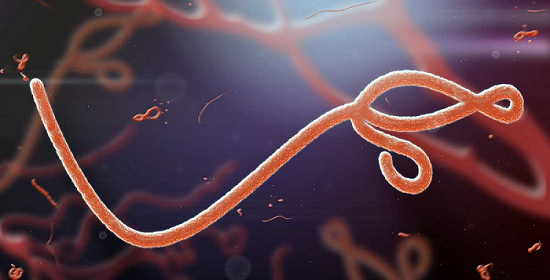
Scientists have announced the creation of the first inhalable Ebola vaccine in what could be a landmark development in the fight against the deadly virus.
Just one dose of the needle-free, aerosolized vaccine conferred full protection against Ebola in rhesus macaques, a species of monkey that shares about 93% of their DNA with humans, according to the results of a new study published in The Journal of Clinical Investigation.
If the finding is confirmed in human trials, the vaccine could revolutionize Ebola treatment and prevention in regions of Africa lacking adequate health facilities.
Since it doesn’t require a syringe, it’s possible patients could administer the new vaccine to themselves, reducing the impact of a shortage of doctors and nurses who presently have to give the current vaccine with a syringe. And as Newsweek reported, it would get around the problem of patients wary of syringes and doctors, which one researcher said was a significant taboo in some west African cultures.
“A needle-free, inhalable vaccine against Ebola presents certain advantages,” said lead author Michelle Meyer, a postdoctoral fellow at the University of Texas Medical Branch at Galveston, in a statement about the research. “Immunization will not require trained medical personnel.”
Furthermore, the researchers said, an aerosolized vaccine could also be useful in chaotic contexts like communities under siege of war, or to protect people should Ebola ever be utilized as a biological weapon.
Vaccine triggered two types of immunity
To create the vaccine, scientists used a parainfluenza virus to carry Ebola’s genetic material. It was delivered by placing a nebulizer over the nose and mouth of the macaques, who then inhaled the vaccine. Once the vaccine entered the macaques’ bodies, it triggered a strong immune response, as measured in the level of antibodies in blood serum and the count of certain immune cells in the blood and lungs.
To see whether the vaccine worked, scientists then exposed the macaques to a massive dose of live Ebola virus to see if they would become infected. None of them became severely ill, and they all survived. Meanwhile, the macaques that were not given the vaccine all died. In humans, the average fatality rate for Ebola is over 50 percent, according to the World Health Organization, while the mortality rate for rhesus macaques used in Ebola research is greater than 95 percent.
Upon closer examination, the researchers discovered that the vaccine actually triggered two different forms of immunity — a “local” immune response, in the mucous membranes of the respiratory tract, as well as a body-wide immune system response, in form of immune cells circulating throughout the body.
Most other Ebola vaccines only stimulate systemic immunity, so the new vaccine could add another layer of protection, said senior author Alex Bukreyev, professor of virology at the University of Texas Medical Branch, Galveston.
“This study demonstrates successful aerosol vaccination against a viral hemorrhagic fever for the first time,” he said. Once approved, the vaccine will advance to phase 1 clinical trials (i.e. human subjects) run by the National Institutes of Health.
When Ebola hit West Africa in 2014, critics all over the world lamented the lack of a vaccine or cure for the virus, despite the fact that the disease was discovered almost 40 years ago. But because of the ferocity of the 2014 Ebola outbreak, which has killed 11,268 and counting, the U.S. approved $5.4 billion in funding, in part to jumpstart research on potential cures and vaccines.
In addition to this aerosolized vaccine, there are ongoing human trials to test other Ebola immunization strategies. In April, the Centers for Disease Control and Prevention launched late-stage trials in Sierra Leone to test a potential vaccine among 6,000 health workers and frontline workers in the country.
Other human trials in Guinea, Australia, and China are underway in various stages, according to the World Health Organization.
